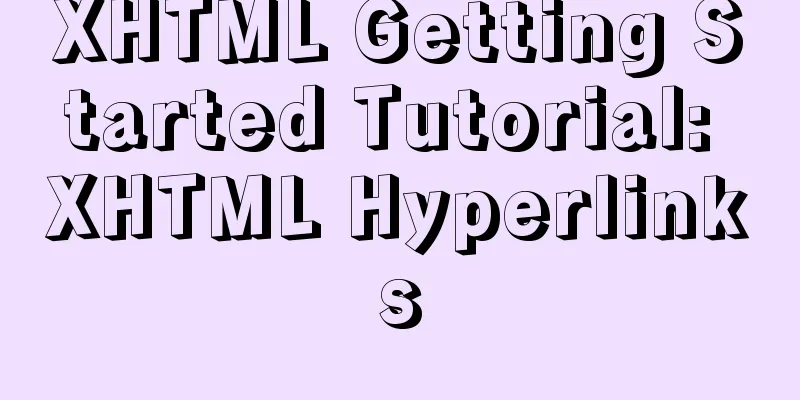XHTML Getting Started Tutorial: XHTML Hyperlinks

|
It is no exaggeration to say that hyperlinks connect the entire Internet. A hyperlink can point to almost any resource on the Internet, such as another web page, a picture, an MP3 song, etc. The syntax for creating a hyperlink using XHTML is very simple, requiring only a pair of <a></a> tags: <a href="URL that this hyperlink will point to">Text or image that will be displayed on the page</a> For example: <a href="https://www.jb51.net/">123WORDPRESS.COM</a> It will be displayed as a hyperlink in the browser, and clicking it will take you to 123WORDPRESS.COM (https://www.jb51.net/). The effect is as follows: 123WORDPRESS.COM The href attribute in the <a> tag is the address that the hyperlink points to. It can be a general URL or an email address. In a later practice example, we will create a hyperlink pointing to an email address. The content (elements) between <a> and </a> will be displayed as a hyperlink on the web page. Note that when the href attribute value is a general URL (absolute path), the "http://" cannot be omitted, otherwise the browser will recognize it as a relative path. The difference between absolute paths and relative paths is beyond the scope of this XHTML tutorial. If you don't understand, you can search for relevant information on Baidu. Hyperlinks (anchors) to jump to within a page When you browse other websites, you may have noticed that there are some hyperlinks that allow you to return to the top of the page or to any other location within the current page. Like the link below: Back to the title <br />The implementation method is as follows. First, add the following code to the title. : <h1>XHTML Beginner's Guide - XHTML Hyperlinks<a id="biaoti"></a></h1> The code for the hyperlink itself is: <a href="#biaoti">Back to title</a> Page jumps allow your users to quickly find the information they need when there is a large amount of content on your page. Usually it is used as a directory in some explanatory web pages. Link Exercise The following exercise adds a hyperlink to the previous "index.html". Open "index.html" and modify the code as follows: <html> The intermediate code is omitted... <p><a href="mailto:[email protected]">Contact me</a></p><!-- Note that you need to change the email address to your own--> <p>Copyright©2005-2006XXX Copyright No</p> </body> </html> After saving, browse your own web page and make sure that your web page is the same as this page. Click on the newly created link. If you have installed email management software such as Outlook, an interface for sending emails to yourself will open. |
<<: Detailed explanation of MYSQL character set setting method (terminal character set)
>>: Detailed explanation of the process of creating floor navigation effects with JavaScript
Recommend
Exploring the practical value of the CSS property *-gradient
Let me first introduce an interesting property - ...
Teach you how to solve the error when storing Chinese characters in MySQL database
Table of contents 1. Problems encountered 2. Anal...
Detailed explanation of how to automatically refresh the page and refresh method after deleting Vue list data
Problem description: After the front-end deletes ...
The best 9 foreign free picture material websites
It is difficult to find good image material websi...
How to calculate the value of ken_len in MySQL query plan
The meaning of key_len In MySQL, you can use expl...
Quickly solve the problem of slow and stuck opening of input[type=file]
Why is it that when the input tag type is file an...
Case study of dynamic data binding of this.$set in Vue
I feel that the explanation of this.$set on the I...
The images in HTML are directly replaced by base64 encoded strings
Recently, I came across a webpage that had images ...
How to use the vue timeline component
This article example shares the specific implemen...
An article to master MySQL index query optimization skills
Preface This article summarizes some common MySQL...
CSS3 flip card number sample code
I received a task from the company today, and the...
How to use squid to build a proxy server for http and https
When we introduced nginx, we also used nginx to s...
js method to delete a field in an object
This article mainly introduces the implementation...
How to use nginx to access local static resources on Linux server
1. Check whether port 80 is occupied. Generally, ...
Analysis of the Poor Performance Caused by Large Offset of LIMIT in MySQL Query
Preface We all know that MySQL query uses the sel...









